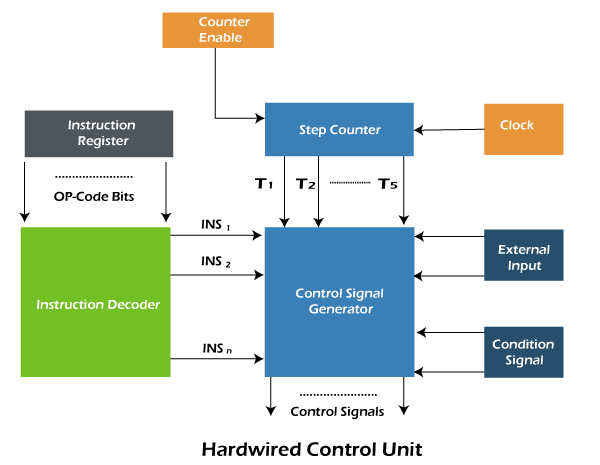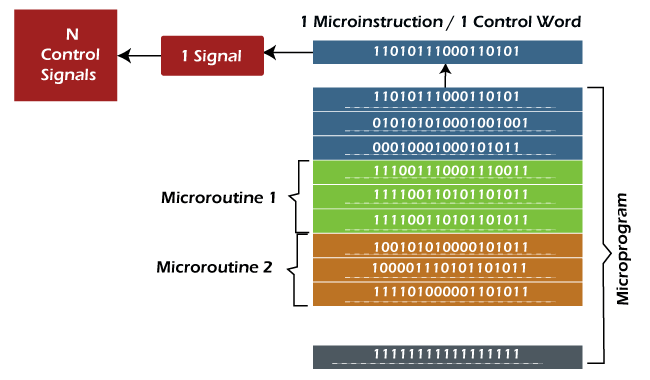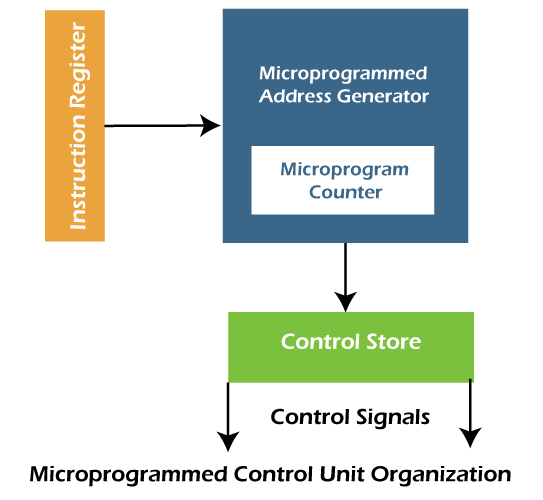Hardwired Vs. Micro-programmed Control UnitIn a system or computer, most of the tasks are controlled with the help of a processor or CPU (Central processing unit), which is the main component of a computer. The CPU usually has two main systems: control unit (CU) and arithmetic and logic unit (ALU). The control unit (CU) is used to synchronize the tasks with the help of sending timings and control signals. On the other hand, mathematical and logical operations can be handled with the help of ALU. Micro programmed control units and hardwired control units can be called two types of control units. We can execute an instruction with the help of these two control units. In the hardwired control unit, the execution of operations is much faster, but the implementation, modification, and decoding are difficult. In contrast, implementing, modifying, decoding micro-programmed control units is very easy. The micro-programmed control unit is also able to handle complex instructions. With the help of control signals generated by micro-programmed and hardwired control units, we are able to fetch and execute the instructions. Control SignalsIn order to generate the control signals, both the control signals were basically designed. The functionality of a processor's hardware is operated with the help of these control signals. The control signals are used to know about various types of things, which are described as follows:
Hardwired Control UnitWith the help of generating control signals, the hardwired control unit is able to execute the instructions at a correct time and proper sequence. As compared to the micro-programmed, the hardwired CU is generally faster. In this CU, the control signals are generated with the help of PLA circuit and state counter. Here the Central processing unit requires all these control signals. With the help of hardware, the hardwired control signals are generated, and it basically uses the circuitry approach. The image of a hardwired control unit is described as follows, which contains various components in the form of circuitry. We will discuss them one by one so that we can properly understand the "generation of control signals". 
So, on the basis of the input obtained by the conditional signals, step counter, external inputs, and instruction register, the control signals will be generated with the help of Control signal Generator. Micro-programmed Control UnitA micro-programmed control unit can be described as a simple logic circuit. We can use it in two ways, i.e., it is able to execute each instruction with the help of generating control signals, and it is also able to do sequencing through microinstructions. It will generate the control signals with the help of programs. At the time of evolution of CISC architecture in the past, this approach was very famous. The program which is used to create the control signals is known as the "Micro-program". The micro-program is placed on the processor chip, which is a type of fast memory. This memory is also known as the control store or control memory. A micro-program is used to contain a set of microinstructions. Each microinstruction or control word contains different bit patterns. The n bit words are contained by each microinstruction. On the basis of the bit pattern of a control word, every control signals differ from each other. Like the above, the instruction execution in a micro-programmed control unit is also performed in steps. So for each step, the micro-program contains a control word/ microinstruction. If we want to execute a particular instruction, we need a sequence of microinstructions. This process is known as the micro-routine. The image of a micro-programmed control unit is described as follows. Here, we will learn the organization of micro-program, micro-routine, and control word/ microinstruction. 
Now we will learn about the organization of Micro-program CU. Then we will learn about the flow of instruction execution with the help of instruction execution steps, which are described as follows: 
So in the micro-programmed control unit, the micro-programs are stored with the help of Control memory or Control store. The implementation of this CU is very easy and flexible, but it is slower as compared to the Hardwired control unit. Differences between Hardwired Control unit and Micro-programmed Control unitThere are various differences between Micro-programmed CU and Hardwired CU, which are described as follows:
Some Other differences between Micro-programmed control unit and Hardwire control unitNow we will describe these differences on the basis of some parameters, such as speed, cost, modification, instruction decoder, control memory, etc. These differences are described as follows: Speed In the hardwired control unit, the speed of operations is very fast. In contrast, the micro-programmed control unit needs frequent memory access. So the speed of operation of a micro-programmed control unit is slow. Modification If we want to do some modifications to the Hardwired control unit, we have to redesign the entire unit. In contrast, if we want to do some modification in the micro-programmed control unit, we can do that just by changing the microinstructions in the control memory. In this case, the more flexible control unit is a micro-programmed control unit. Cost The implementation of a Hardwire control unit is very much compared to the Micro-programmed control unit. In this case, the micro-programmed control unit will save our money at the time of implementation. Handling Complex Instructions If we try to handle the complex instructions with the help of a hardwired control unit, it will be very difficult for us to handle them. But if we try to handle the complex instructions with the help of micro-programmed control unit, it will be very easy for us to handle them. In this case also, the Micro-programmed control unit is better. Instruction decoding In the hardwired control unit, if we want to perform instruction decoding, it will be very difficult. But if we do the same thing in a micro-programmed control unit, it will be very easy for us. Instruction set size A small instruction set is used by the hardwired CU. On the other hand, a large instruction set is used by the micro-programmed control unit. Control Memory The hardwired control unit does not use the control memory to generate the control signals, but the micro-programmed CU needs to use the control memory to generate the control signals. Applications The hardwired control unit is used in those types of processors that basically use a simple instruction set. This set is called a Reduced Instruction Set Computer. On the other hand, a micro-programmed control unit is used in those types of processors that basically use a complex instruction set. This set is called a Complex Instruction Set Computer. ConclusionIn conclusion, we can say that the Hardwired control unit is a type of sequential circuit used to generate the control signals. In contrast, the micro-programmed control unit is a type of unit used to contain the microinstruction in the control memory so that they can generate the control signals. This is the main difference between both the control units. The similarity between hardwired and micro-programmed control units is that both control units generate the 'Control Signals'. |
 For Videos Join Our Youtube Channel: Join Now
For Videos Join Our Youtube Channel: Join Now
Feedback
- Send your Feedback to [email protected]
Help Others, Please Share









